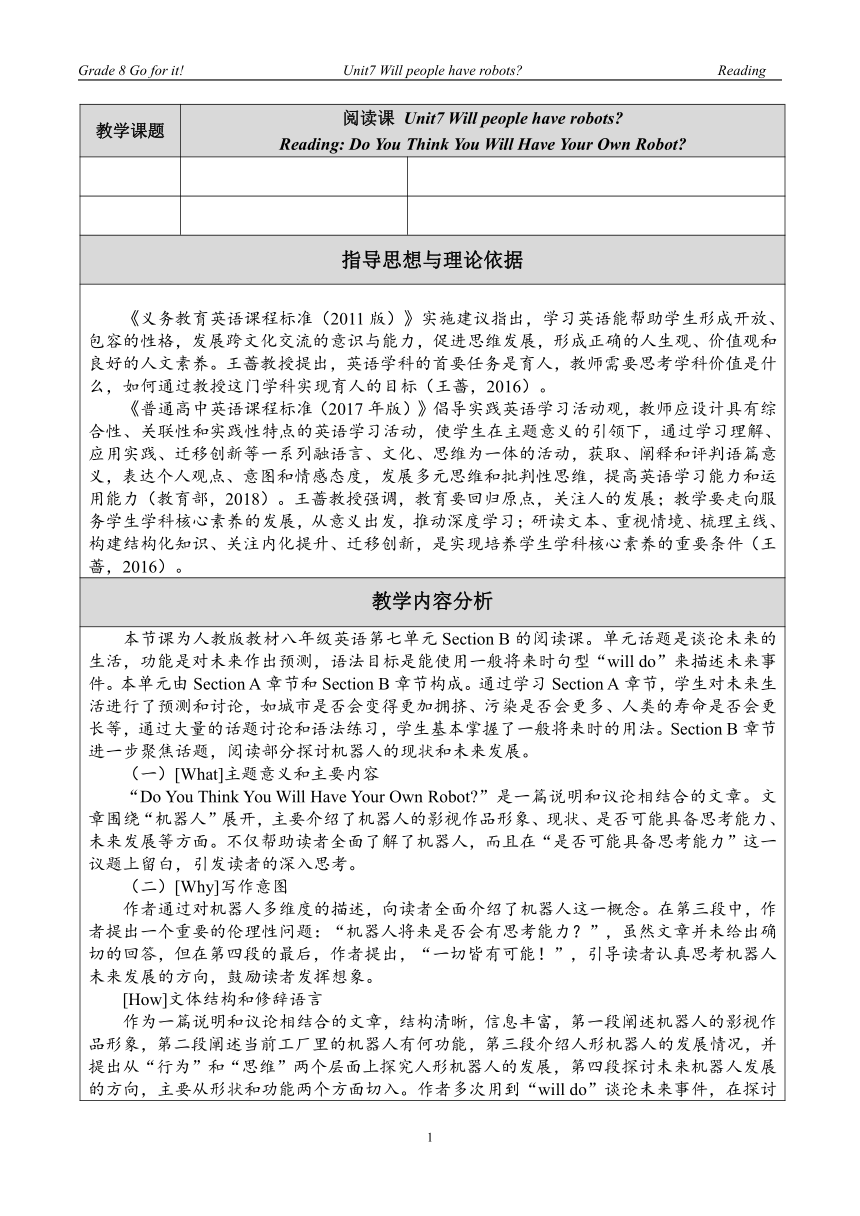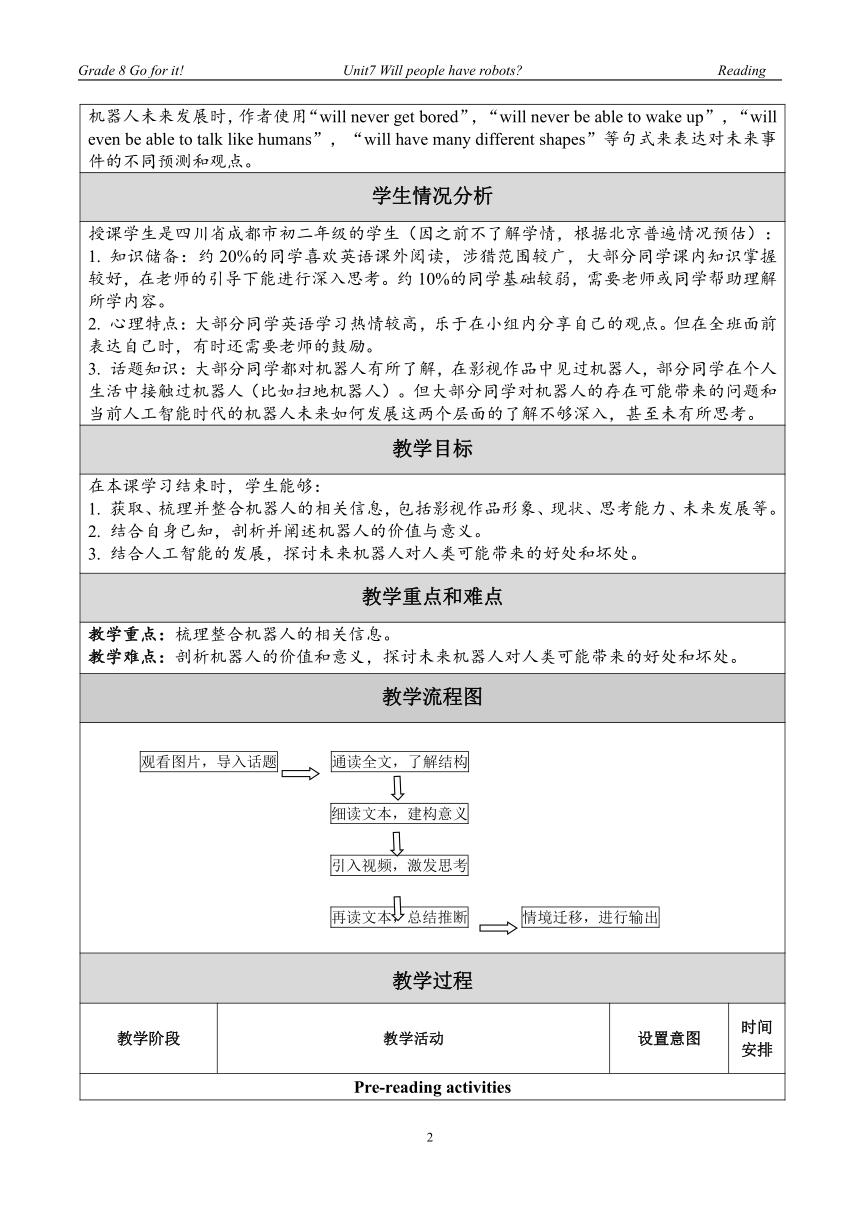八上Unit 7 Will people have robots? Reading 教学设计(表格式)
文档属性
| 名称 | 八上Unit 7 Will people have robots? Reading 教学设计(表格式) |

|
|
| 格式 | doc | ||
| 文件大小 | 349.7KB | ||
| 资源类型 | 教案 | ||
| 版本资源 | 人教新目标(Go for it)版 | ||
| 科目 | 英语 | ||
| 更新时间 | 2022-08-15 17:06:38 | ||
图片预览


文档简介
Grade 8 Go for it! Unit7 Will people have robots Reading
教学课题 阅读课 Unit7 Will people have robots Reading: Do You Think You Will Have Your Own Robot
指导思想与理论依据
《义务教育英语课程标准(2011版)》实施建议指出,学习英语能帮助学生形成开放、包容的性格,发展跨文化交流的意识与能力,促进思维发展,形成正确的人生观、价值观和良好的人文素养。王蔷教授提出,英语学科的首要任务是育人,教师需要思考学科价值是什么,如何通过教授这门学科实现育人的目标(王蔷,2016)。《普通高中英语课程标准(2017年版)》倡导实践英语学习活动观,教师应设计具有综合性、关联性和实践性特点的英语学习活动,使学生在主题意义的引领下,通过学习理解、应用实践、迁移创新等一系列融语言、文化、思维为一体的活动,获取、阐释和评判语篇意义,表达个人观点、意图和情感态度,发展多元思维和批判性思维,提高英语学习能力和运用能力(教育部,2018)。王蔷教授强调,教育要回归原点,关注人的发展;教学要走向服务学生学科核心素养的发展,从意义出发,推动深度学习;研读文本、重视情境、梳理主线、构建结构化知识、关注内化提升、迁移创新,是实现培养学生学科核心素养的重要条件(王蔷,2016)。
教学内容分析
本节课为人教版教材八年级英语第七单元Section B的阅读课。单元话题是谈论未来的生活,功能是对未来作出预测,语法目标是能使用一般将来时句型“will do”来描述未来事件。本单元由Section A章节和Section B章节构成。通过学习Section A章节,学生对未来生活进行了预测和讨论,如城市是否会变得更加拥挤、污染是否会更多、人类的寿命是否会更长等,通过大量的话题讨论和语法练习,学生基本掌握了一般将来时的用法。Section B章节进一步聚焦话题,阅读部分探讨机器人的现状和未来发展。(一)[What]主题意义和主要内容“Do You Think You Will Have Your Own Robot ”是一篇说明和议论相结合的文章。文章围绕“机器人”展开,主要介绍了机器人的影视作品形象、现状、是否可能具备思考能力、未来发展等方面。不仅帮助读者全面了解了机器人,而且在“是否可能具备思考能力”这一议题上留白,引发读者的深入思考。(二)[Why]写作意图作者通过对机器人多维度的描述,向读者全面介绍了机器人这一概念。在第三段中,作者提出一个重要的伦理性问题:“机器人将来是否会有思考能力?”,虽然文章并未给出确切的回答,但在第四段的最后,作者提出,“一切皆有可能!”,引导读者认真思考机器人未来发展的方向,鼓励读者发挥想象。[How]文体结构和修辞语言作为一篇说明和议论相结合的文章,结构清晰,信息丰富,第一段阐述机器人的影视作品形象,第二段阐述当前工厂里的机器人有何功能,第三段介绍人形机器人的发展情况,并提出从“行为”和“思维”两个层面上探究人形机器人的发展,第四段探讨未来机器人发展的方向,主要从形状和功能两个方面切入。作者多次用到“will do”谈论未来事件,在探讨机器人未来发展时,作者使用“will never get bored”,“will never be able to wake up”,“will even be able to talk like humans”,“will have many different shapes”等句式来表达对未来事件的不同预测和观点。
学生情况分析
授课学生是四川省成都市初二年级的学生(因之前不了解学情,根据北京普遍情况预估):1. 知识储备:约20%的同学喜欢英语课外阅读,涉猎范围较广,大部分同学课内知识掌握较好,在老师的引导下能进行深入思考。约10%的同学基础较弱,需要老师或同学帮助理解所学内容。2. 心理特点:大部分同学英语学习热情较高,乐于在小组内分享自己的观点。但在全班面前表达自己时,有时还需要老师的鼓励。3. 话题知识:大部分同学都对机器人有所了解,在影视作品中见过机器人,部分同学在个人生活中接触过机器人(比如扫地机器人)。但大部分同学对机器人的存在可能带来的问题和当前人工智能时代的机器人未来如何发展这两个层面的了解不够深入,甚至未有所思考。
教学目标
在本课学习结束时,学生能够: 获取、梳理并整合机器人的相关信息,包括影视作品形象、现状、思考能力、未来发展等。结合自身已知,剖析并阐述机器人的价值与意义。结合人工智能的发展,探讨未来机器人对人类可能带来的好处和坏处。
教学重点和难点
教学重点:梳理整合机器人的相关信息。教学难点:剖析机器人的价值和意义,探讨未来机器人对人类可能带来的好处和坏处。
教学流程图
观看图片,导入话题 通读全文,了解结构 细读文本,建构意义 引入视频,激发思考 再读文本,总结推断 情境迁移,进行输出
教学过程
教学阶段 教学活动 设置意图 时间安排
Pre-reading activities
Step1Lead-in Ss answer three questions: Who is the tallest in our class Who is the fastest in our class Who is the strongest in our class Ss look at a robot picture and compare themselves with it to see who is stronger.Ss brainstorm the robots they know and share with the class about their shapes and functions. 引出“机器人”话题,激活学生已知,激发阅读兴趣。 3’
While-reading activities
Step21st reading Ss read through the article and summarize what each paragraph is mainly about by drawing a mind map. Ss who find the task difficult may put in key words from each paragraph. 通读全文,获得整体感知,了解文章结构,建立思维导图。 5’
Step 32nd reading read Para.1&2 and think Ss read Para.1 and Para.2 and then fill in the blanks.Ss think and discuss: What will happen to humans when lots of robots work in factories 获取机器人的影视形象和工厂机器人信息,并深入思考工厂机器人对人类的利弊。 4’
read Para.3 and think Ss read Para.3 to answer the questions: What can human-like robots do today What might be the difficulty in their future development Ss focus on the question: Will robots think like humans Ss watch the videos of Sophia, the AI robot and think and discuss: What will happen to humans when robots can think by themselves 从人形机器人的“行为能力”和“思考能力”两个层面切入,探究主题意义。 8’
read Para.4 and think Ss read Para.4 to summarize and predict the shapes and functions of future robots. 思考机器人的未来发展,激发学生想象预测。 3’
review Ss polish the mind map of the article and retell what they’ve learned about robots in this article. 回顾全文,优化思维导图,整合信息,并对文章进行内化。 4’
Post-reading activities
Step 4Further thinking Ss think deeper:Why do we create robots What good qualities do robots have What good and bad effects will robots bring on the human society 分析、概括、推理,判断,剖析字里行间的意义,思考人工智能时代的机器人可能带给人类的好处和坏处。 5’
Step 5Practice and presentation Ss form into groups of four to design a robot for the school in the future. Ss give a presentation about the robot design:What will it be like What will it do 结合本课所学,充分发挥想象力,为学校设计一个未来机器人,并介绍该机器人的性能。 8’
Homework
Polish your group's robot design and write down the introduction of the robot after class.
板书设计
附件:Unit 7 Will people have robots —— Reading Text
Do You Think You Will Have Your Own Robot
When we watch movies about the future, we sometimes see robots. They are usually like human servants. They help with the housework and do jobs like working in dirty or dangerous places.
Today there are already robots working in factories. They can help to build cars, and they do simple jobs over and over again. Fewer people will do such jobs in the future because they are boring, but robots will never get bored.
Scientists are now trying to make robots look like humans and do the same things as we do. Some robots in Japan can walk and dance. They are fun to watch. However, some scientists believe that although we can make robots move like people, it will be difficult to make them really think like a human. For example, scientist James White thinks that robots will never be able to wake up and know where they are. But many scientists disagree with Mr. White. They think that robots will even be able to talk like humans in 25 to 50 years.
Some scientists believe that there will be more robots in the future. However, they agree it may take hundreds of years. These new robots will have many different shapes. Some will look like humans, and others might look like animals. In India, fore example, scientists made robots that look like snakes. If buildings fall down with people inside, these snake robots can help look for people under the buildings. This was not possible 20 years ago, but computers and rockets also seemed impossible 100 years ago. We never know what will happen in the future!
教学课题 阅读课 Unit7 Will people have robots Reading: Do You Think You Will Have Your Own Robot
指导思想与理论依据
《义务教育英语课程标准(2011版)》实施建议指出,学习英语能帮助学生形成开放、包容的性格,发展跨文化交流的意识与能力,促进思维发展,形成正确的人生观、价值观和良好的人文素养。王蔷教授提出,英语学科的首要任务是育人,教师需要思考学科价值是什么,如何通过教授这门学科实现育人的目标(王蔷,2016)。《普通高中英语课程标准(2017年版)》倡导实践英语学习活动观,教师应设计具有综合性、关联性和实践性特点的英语学习活动,使学生在主题意义的引领下,通过学习理解、应用实践、迁移创新等一系列融语言、文化、思维为一体的活动,获取、阐释和评判语篇意义,表达个人观点、意图和情感态度,发展多元思维和批判性思维,提高英语学习能力和运用能力(教育部,2018)。王蔷教授强调,教育要回归原点,关注人的发展;教学要走向服务学生学科核心素养的发展,从意义出发,推动深度学习;研读文本、重视情境、梳理主线、构建结构化知识、关注内化提升、迁移创新,是实现培养学生学科核心素养的重要条件(王蔷,2016)。
教学内容分析
本节课为人教版教材八年级英语第七单元Section B的阅读课。单元话题是谈论未来的生活,功能是对未来作出预测,语法目标是能使用一般将来时句型“will do”来描述未来事件。本单元由Section A章节和Section B章节构成。通过学习Section A章节,学生对未来生活进行了预测和讨论,如城市是否会变得更加拥挤、污染是否会更多、人类的寿命是否会更长等,通过大量的话题讨论和语法练习,学生基本掌握了一般将来时的用法。Section B章节进一步聚焦话题,阅读部分探讨机器人的现状和未来发展。(一)[What]主题意义和主要内容“Do You Think You Will Have Your Own Robot ”是一篇说明和议论相结合的文章。文章围绕“机器人”展开,主要介绍了机器人的影视作品形象、现状、是否可能具备思考能力、未来发展等方面。不仅帮助读者全面了解了机器人,而且在“是否可能具备思考能力”这一议题上留白,引发读者的深入思考。(二)[Why]写作意图作者通过对机器人多维度的描述,向读者全面介绍了机器人这一概念。在第三段中,作者提出一个重要的伦理性问题:“机器人将来是否会有思考能力?”,虽然文章并未给出确切的回答,但在第四段的最后,作者提出,“一切皆有可能!”,引导读者认真思考机器人未来发展的方向,鼓励读者发挥想象。[How]文体结构和修辞语言作为一篇说明和议论相结合的文章,结构清晰,信息丰富,第一段阐述机器人的影视作品形象,第二段阐述当前工厂里的机器人有何功能,第三段介绍人形机器人的发展情况,并提出从“行为”和“思维”两个层面上探究人形机器人的发展,第四段探讨未来机器人发展的方向,主要从形状和功能两个方面切入。作者多次用到“will do”谈论未来事件,在探讨机器人未来发展时,作者使用“will never get bored”,“will never be able to wake up”,“will even be able to talk like humans”,“will have many different shapes”等句式来表达对未来事件的不同预测和观点。
学生情况分析
授课学生是四川省成都市初二年级的学生(因之前不了解学情,根据北京普遍情况预估):1. 知识储备:约20%的同学喜欢英语课外阅读,涉猎范围较广,大部分同学课内知识掌握较好,在老师的引导下能进行深入思考。约10%的同学基础较弱,需要老师或同学帮助理解所学内容。2. 心理特点:大部分同学英语学习热情较高,乐于在小组内分享自己的观点。但在全班面前表达自己时,有时还需要老师的鼓励。3. 话题知识:大部分同学都对机器人有所了解,在影视作品中见过机器人,部分同学在个人生活中接触过机器人(比如扫地机器人)。但大部分同学对机器人的存在可能带来的问题和当前人工智能时代的机器人未来如何发展这两个层面的了解不够深入,甚至未有所思考。
教学目标
在本课学习结束时,学生能够: 获取、梳理并整合机器人的相关信息,包括影视作品形象、现状、思考能力、未来发展等。结合自身已知,剖析并阐述机器人的价值与意义。结合人工智能的发展,探讨未来机器人对人类可能带来的好处和坏处。
教学重点和难点
教学重点:梳理整合机器人的相关信息。教学难点:剖析机器人的价值和意义,探讨未来机器人对人类可能带来的好处和坏处。
教学流程图
观看图片,导入话题 通读全文,了解结构 细读文本,建构意义 引入视频,激发思考 再读文本,总结推断 情境迁移,进行输出
教学过程
教学阶段 教学活动 设置意图 时间安排
Pre-reading activities
Step1Lead-in Ss answer three questions: Who is the tallest in our class Who is the fastest in our class Who is the strongest in our class Ss look at a robot picture and compare themselves with it to see who is stronger.Ss brainstorm the robots they know and share with the class about their shapes and functions. 引出“机器人”话题,激活学生已知,激发阅读兴趣。 3’
While-reading activities
Step21st reading Ss read through the article and summarize what each paragraph is mainly about by drawing a mind map. Ss who find the task difficult may put in key words from each paragraph. 通读全文,获得整体感知,了解文章结构,建立思维导图。 5’
Step 32nd reading read Para.1&2 and think Ss read Para.1 and Para.2 and then fill in the blanks.Ss think and discuss: What will happen to humans when lots of robots work in factories 获取机器人的影视形象和工厂机器人信息,并深入思考工厂机器人对人类的利弊。 4’
read Para.3 and think Ss read Para.3 to answer the questions: What can human-like robots do today What might be the difficulty in their future development Ss focus on the question: Will robots think like humans Ss watch the videos of Sophia, the AI robot and think and discuss: What will happen to humans when robots can think by themselves 从人形机器人的“行为能力”和“思考能力”两个层面切入,探究主题意义。 8’
read Para.4 and think Ss read Para.4 to summarize and predict the shapes and functions of future robots. 思考机器人的未来发展,激发学生想象预测。 3’
review Ss polish the mind map of the article and retell what they’ve learned about robots in this article. 回顾全文,优化思维导图,整合信息,并对文章进行内化。 4’
Post-reading activities
Step 4Further thinking Ss think deeper:Why do we create robots What good qualities do robots have What good and bad effects will robots bring on the human society 分析、概括、推理,判断,剖析字里行间的意义,思考人工智能时代的机器人可能带给人类的好处和坏处。 5’
Step 5Practice and presentation Ss form into groups of four to design a robot for the school in the future. Ss give a presentation about the robot design:What will it be like What will it do 结合本课所学,充分发挥想象力,为学校设计一个未来机器人,并介绍该机器人的性能。 8’
Homework
Polish your group's robot design and write down the introduction of the robot after class.
板书设计
附件:Unit 7 Will people have robots —— Reading Text
Do You Think You Will Have Your Own Robot
When we watch movies about the future, we sometimes see robots. They are usually like human servants. They help with the housework and do jobs like working in dirty or dangerous places.
Today there are already robots working in factories. They can help to build cars, and they do simple jobs over and over again. Fewer people will do such jobs in the future because they are boring, but robots will never get bored.
Scientists are now trying to make robots look like humans and do the same things as we do. Some robots in Japan can walk and dance. They are fun to watch. However, some scientists believe that although we can make robots move like people, it will be difficult to make them really think like a human. For example, scientist James White thinks that robots will never be able to wake up and know where they are. But many scientists disagree with Mr. White. They think that robots will even be able to talk like humans in 25 to 50 years.
Some scientists believe that there will be more robots in the future. However, they agree it may take hundreds of years. These new robots will have many different shapes. Some will look like humans, and others might look like animals. In India, fore example, scientists made robots that look like snakes. If buildings fall down with people inside, these snake robots can help look for people under the buildings. This was not possible 20 years ago, but computers and rockets also seemed impossible 100 years ago. We never know what will happen in the future!
同课章节目录
- Unit 1 Where did you go on vacation?
- Section A
- Section B
- Unit 2 How often do you exercise?
- Section A
- Section B
- Unit 3 I'm more outgoing than my sister.
- Section A
- Section B
- Unit 4 What's the best movie theater?
- Section A
- Section B
- Unit 5 Do you want to watch a game show?
- Section A
- Section B
- Unit 6 I'm going to study computer science.
- Section A
- Section B
- Unit 7 Will people have robots?
- Section A
- Section B
- Unit 8 How do you make a banana milk shake?
- Section A
- Section B
- Unit 9 Can you come to my party?
- Section A
- Section B
- Unit 10 If you go to the party, you'll have a grea
- Section A
- Section B
